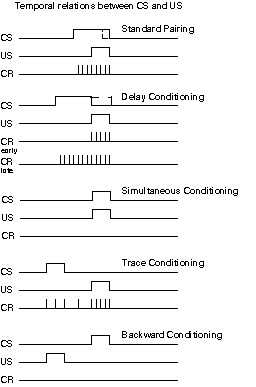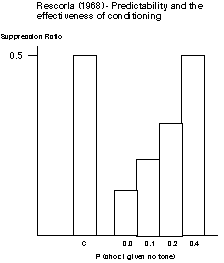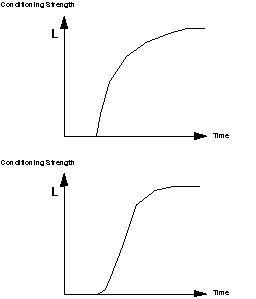16. Contiguity
CS and US timing (contiguity)is crucial to Pavlovian conditioning. As can be seen in the figure below: With delay conditioning the salivation elicited by the US gradually extends backwards as it becomes associated with the US. In the standard paradigm the same thing happens although it is a little less obvious because of the overlap between the CS and US. In trace conditioning the strength of the CR is generally inversely related to the delay between the CS and US. The same cannot be happening in backwards conditioning which is usually ineffective. Thus a vital feature of successful CS-US pairing in time seems to be that the CS can be used to predict the occurrence of the US. This suggestion may also explain one of the most surprising results - if the CS and US are presented exactly simultaneously, so that both the onset and offset both occur together, then conditioning fails.
CS and US timing (contiguity)is crucial to Pavlovian conditioning. As can be seen in the figure below: With delay conditioning the salivation elicited by the US gradually extends backwards as it becomes associated with the US. In the standard paradigm the same thing happens although it is a little less obvious because of the overlap between the CS and US. In trace conditioning the strength of the CR is generally inversely related to the delay between the CS and US. The same cannot be happening in backwards conditioning which is usually ineffective. Thus a vital feature of successful CS-US pairing in time seems to be that the CS can be used to predict the occurrence of the US. This suggestion may also explain one of the most surprising results - if the CS and US are presented exactly simultaneously, so that both the onset and offset both occur together, then conditioning fails.

17. Contingency (Predictability)
In order to examine whether contingency is important above and beyond the number of times the CS and US occur together, you could require a procedure in which the correlation between CS and US occurrence is varied while the total number of times the subjects are exposed CS-US pairings are held fixed. An experiment which examined this question was devised by Rescorla (1968). He took four groups of rats and exposed them all to tone-shock pairings While a target behavior (lever pressing was occuring-- the Dependent Variable of the CR is going to be the degree to which that lever pressing is suppressed by the CS). In each test session the animals heard a number of 2 minute tones interspersed by silences. For all groups the probability that they would experience a shock while hearing the tone was 0.4. The groups differed in the probability that they were also shocked during the silences occurring between tones - one group received no shocks during these intervals (a probability of 0.0), the other groups received shocks during the 'no tone' intervals with probabilities of 0.1, 0.2 and 0.4. So, although all the groups receive the same number of tone-shock pairings the tone becomes a progressively better predictor of shock as the probability of shock occurring during the 'no-tone' intervals decreases. He also tested a control group who received no shocks but heard the same number of tones as the experimental groups. The results below clearly show that CS-US predictability is an important factor in determining the efficacy of conditioning - the more the experimental groups were shocked during no-tone intervals the less the tone could predict shock and the less an ongoing target behavior (lever pressing) was suppressed by the tone (see the diagram below):

18. Overshadowing
19. Blocking
In addition to variations in the subjective characteristics, variations in the history of these experiences were also investigated. Suppose that two stimuli CS1 and CS2 will be paired with a single US. Rather than presenting the two CSs together throughout the training of an animal only CS1 is used in the first half of training and later the CS1-CS2 combination together, just as in an overshadowing experiment for the second half of training. The result, in general, is that when subsequently tested individually the animal will show strong conditioning to CS1 and little or no conditioning to CS2. The effect where the prior pairing of one stimulus with a US stops the US being associated with other subsequently presented stimuli is called blocking.
Procedure for a simple blocking experiment:
| Group Name | 1st Training | 2nd Training | Test |
| Blocking | CS1-US | CS1-CS2 and US | CS2 alone |
| Control | nothing | CS1-CS2 and US | CS2 alone |
In order to compare the effectiveness of overshadowing vs. blocking and include some measure for the predictability of the CSs, a "blocking and predictability" experiment could be devised:
| Group Name | 1st Training | 2nd Training | Test |
| Correlated | Correlated CS1 and US | CS1-CS2 and US | CS2 alone |
| Uncorrelated | Uncorrelated CS1 and US | CS1-CS2 and US | CS2 alone |
| Overshadowing | US alone | CS1-CS2 and US | CS2 alone |
| No US | CS1 alone | CS1-CS2 and US | CS2 alone |
20. Rescorla and Wagner's model of classical conditioning
This is an example of Preparatory Response or information processing explanation of Pavlovian Learning.
According to Rescorla and Kamin, associations are only learned when a surprising event accompanies a CS. In a normal simple conditioning experiment the US is surprising the first few times it is experienced so it is associated with salient stimuli which immediately precede it. In a blocking experiment once the association between the CS (CS1) presented in the first phase of the procedure and the US has been made the US is no longer surprising (since it is predicted by CS1). In the second phase, where both CS1 and CS2 are experienced, as the US is no longer surprising it does not induce any further learning and so no association is made between the US and CS2. This explanation was presented by Rescorla and Wagner (1972) as a formal model of conditioning which expresses the capacity a CS has to become associated with a US at any given time. This associative strength of the US to the CS is referred to by the letter V and the change in this strength which occurs on each trial of conditioning is called dV. The more a CS is associated with a US the less additional association the US can induce. This informal explanation of the role of US surprise and of CS (and US) salience in the process of conditioning can be stated as follows:
dV = ab(L - V)
where a is the salience (intensity) of the US, b is the salience (intensity) of the CS and L is the amount of processing given to a completely unpredicted US. In words: when the US is first encountered the CS has no association to it so V is zero. On the first trial the CS gains a strength of abL in its association with the US which is proportional to the saliences of the CS and the US and to the initial amount of processing given to the US. As we start trial two the associative strength is V is abL so the change in strength that occurs with the second pairing of the CS and US is ab(L - abL). It is smaller than the amount learned on the first trial and this reduction in amount that is learned reflects the fact that the CS now has some association with the US, so the US is less surprising (cute...very cute--oops I'm not supposed to impose my opinions). As more trials ensue, the equation predicts a gradually decreasing rate of learning which reaches an asymptote at L.
However, the diagram below shows: this is not what is seen when the development CS-US associations is measured over time. Instead the learning curve is sigmoidal. Rescorla has argued that the equation is consistent with observed behavior if one assumes that very small changes in associative strength are undetectable and that there is a limit to the amount of effect that very large changes can have on behavior.

CS-US aquisition
There are other respects, however, where the model performs better in predicting experimental outcomes. It can also be applied to a number of CSs each of which contributes to an overall associative strength V of the US in the right hand side of the equation. It is reasonably clear that the presence of the CS salience term b in the equation lets it account for overshadowing. The meaning of the equation is clearest if the specific dVs on the left hand side are seen as referring to the increments in association between specific CSs while V on the right hand side is referring to the predictability of the US and so is the sum of all the different CS-US associations. If the conditioning strength accrued to CS1 is denoted by dV1 and that to CS2 by dV2 then our equations are:
dV1 = ab1(L - V)
dV2 = ab2(L - V)
and both dV1 and dV2 accrue to V on each trial. The amount of association directed to each CS is proportional to their salience.
The equation also models blocking well. During the initial phase of a blocking experiment the associative strength of the US is increased so later, when a second CS is presented the amount of associative strength it can gain has been reduced.
The critical question is, however, does the model predict experimental outcomes it was not explicitly divised for, i.e. can it be generalized? In one example the model predicts the effects of pairing two previously learned CSs on learning about a third new stimulus. If on separate occasions (not as compound stimuli) two CSs of equal salience have both been completely associated with a US then V=L for both stimuli and dV on subsequent trials is zero for both. Now a third CS in conjunction with the original pair is presented so three CSs are presented together whereas only two of them were presented singly in the past. The overall associative strength of the US is now 2L, a contribution of L from both of the original CSs. The equation predicts that there will be a negative change in associative strength on this trial proportional to the salience of the CSs:
dV = ab(L - 2L)
dV = -abL
Conducting the experiment shows: the third stimulus becomes a conditioned inhibitor of the US - it provokes a CR of the opposite quality to that produced by the other two CSs.
So you can see that there is more to this stuff than a drooling dog...for best results please read Chapter 3 (and keep it out of reach of small children).

